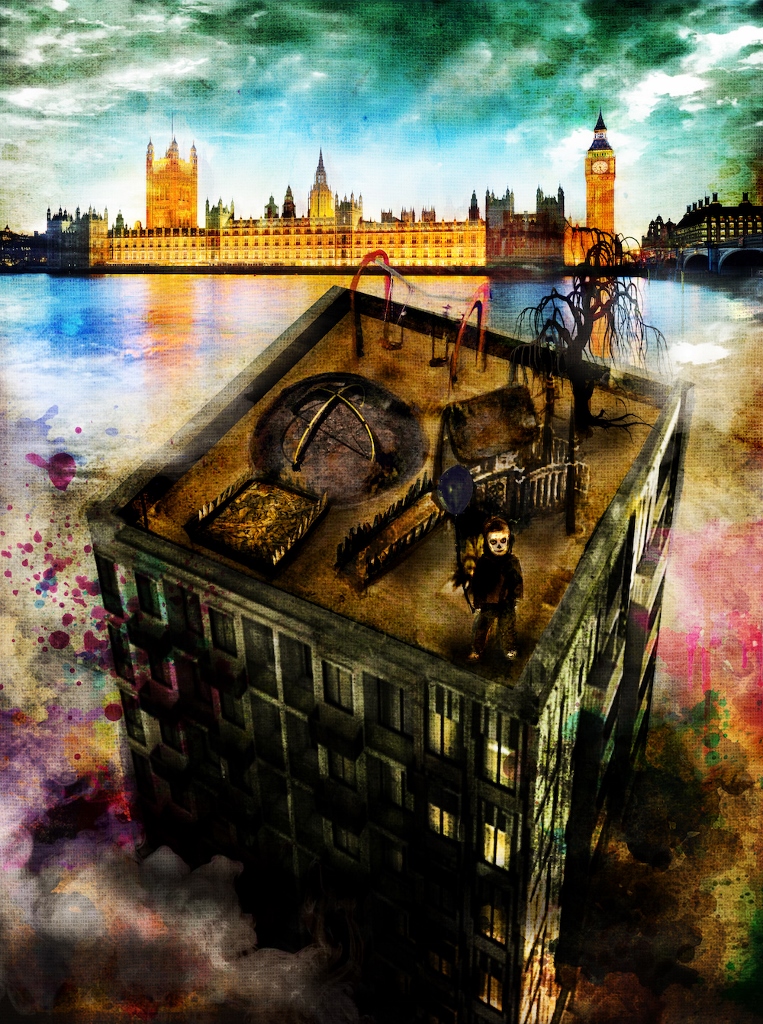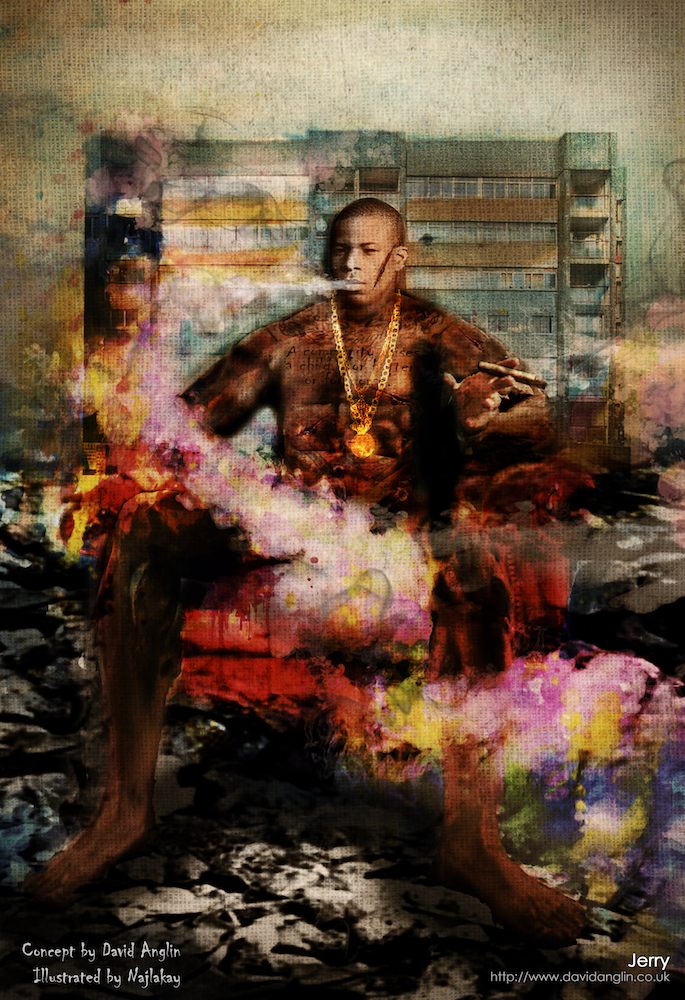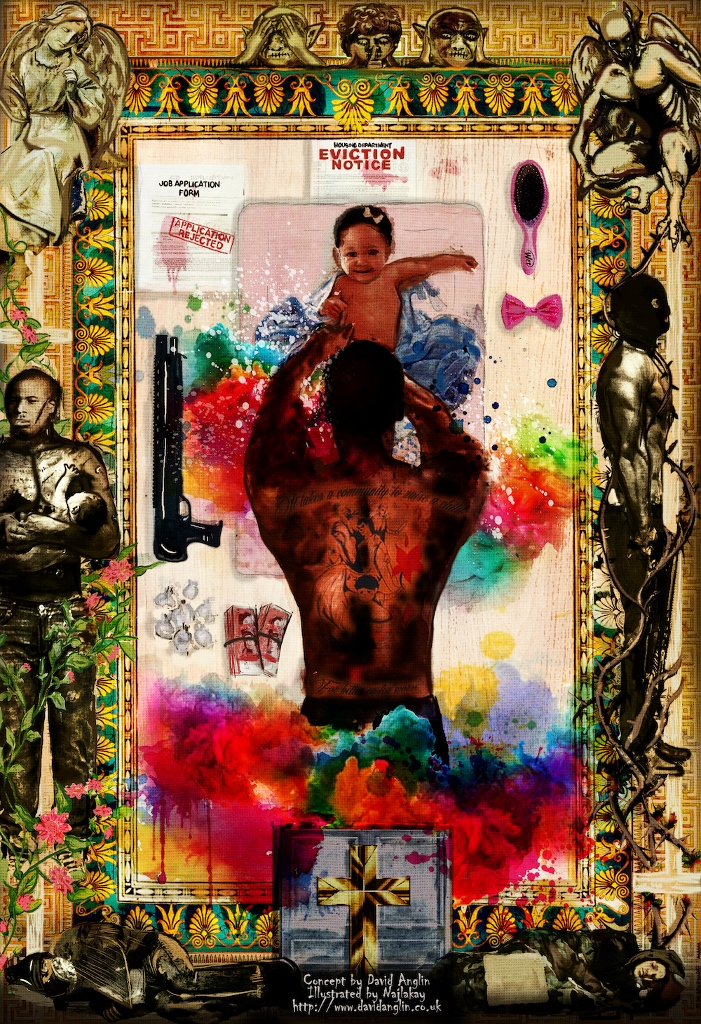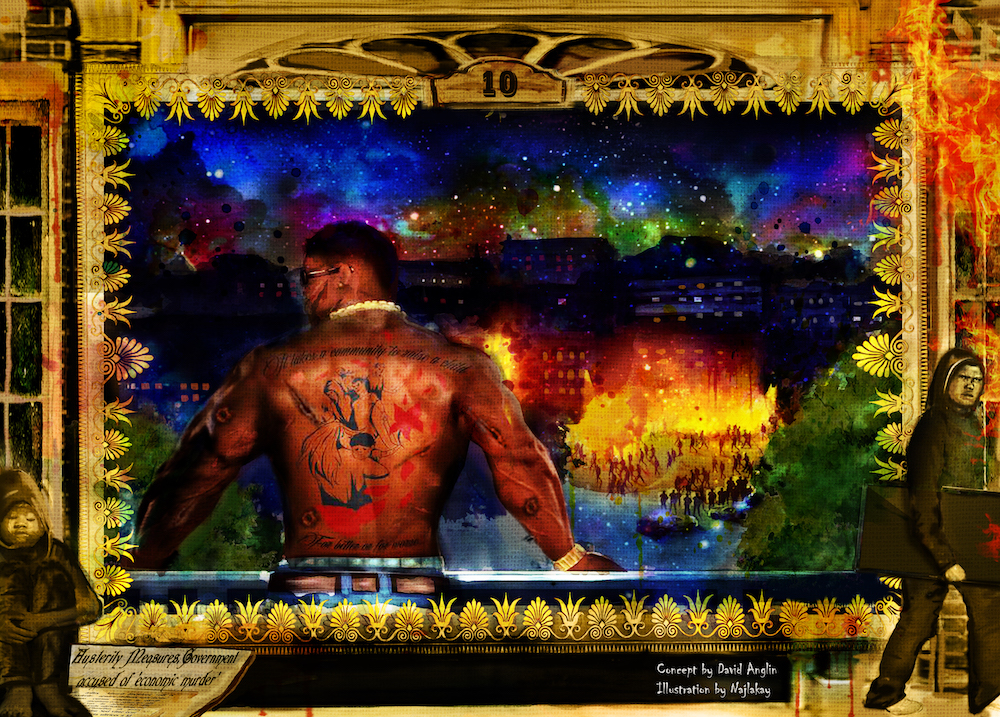David Anglin spent over 10 years working with some of London’s most extreme offenders, the insights that he shares provide a real life perspective into just how far the battle goes when trying to change the mindset of these hard-to-reach young people. David through his art is telling tales of vibrant characters, to make you laugh, and to make you cry. To get you thinking. To get you changing. In the hopes of generating action.
G: Tell us about What do you do and Why are you doing this?
D: I’m an 80’s baby who started life of on a council estate in Chingford, East London. When I was young, seeing my dad caught in the prison system for considerable periods and witnessing how my older brother ended up following a similar route, in addition to going through my own trials and tribulations; set me on the path of wanting to provide guidance for young people who’d found themselves in the criminal justice system.
For me I can honestly say I got into working with young offenders from having a genuine passion of wanting to help change some of the toxic environments and thinking patterns that some of the young people emerged from.
Doing this kind of work for the last 10 years combined with my own personal experiences growing up, was the reason I begun working on giving life to these experiences through creating thought-provoking art concepts and short stories. The creative process for me is like a catharsis, as creating art and writing stories is something I’ve done from a young age, so it gives me a creative release from some of the issues I find myself dealing with at times, I suppose its like the art piece I created; ‘Paid The Cost To Be The Boss.’
G: What are the lessons that you have learned from these young offenders as an artist and as a person throughout your life?
D: I’ll give you a scenario, I remember one time stepping into the office and at reception sat this tall English lad, where anger and aggression just radiated from him, and it wasn’t like he was doing anything bad, he was just sat there quietly.
But the intensity that came from him was just phenomenal. I was told that I would be working with him and if I’m to be honest I was wondering how I would be able to get through to him to start any kind of work, as I could see that he was in such a dark place.
During a session we were driving to a charity as part of giving back through community service, we started speaking as I’d managed to break the ice and he talked about just coming out of jail and not letting any screw (prison warden) chat rubbish to him as he wouldn’t have it as who were they to tell him that he couldn’t come out his cell. In his own words he said, “I would not have it, I’ll start a riot.” I remember saying to him but you know that level of aggression won’t work outside; the general public aren’t use to that. If something doesn’t change they’ll end up locking you up for life.
He didn’t take offence at my comments as it was said from a genuine and caring place and from this initial conversation of just being real with one another, we were able to have further conversations where we could laugh and joke and in more serious moments he told me that he drank a bottle of Couvoisier brandy every day. I later found out that when he was younger he’d been sexually abused.
Working with so many young people throughout the years, I’ve learned that 8 out of 10 times there’s usually a back story and it’s usually tragic, sometimes I think the general public just doesn’t understand how deeply childhood conflicts can affect people, especially with the media not really giving light to these circumstances. That’s why in the prologue to my novelette Jerry I try to dive deep in showcasing just how some young offenders start out.
Showing respect, empathy and being true to your word are traits that universally people will take to, working with young offenders constantly reminds me of the importance of these characteristics and why it’s so important to not judge a book by its cover; as usually there’s a completely different story to what you’d expect.

G: What are the main problems that we as a society are facing in terms of crime and in your opinion how can ordinary people help to fight this?
D: If you have a look at a lot of my artwork that deals with social issues, you’ll often see somewhere the words to the effect of; ‘it takes a community to raise a child’. I repeat this as the child grows into what’s required in becoming a member of that community. If a child is from a community that priorities nurturing, love, care, and an abundance of opportunities; he’ll choose routes that gear him for becoming an integral part of that community. However, if a child grows into a community where poverty is endemic, violence is a means to an end and opportunism over actual opportunities, then he too will grow into what’s necessary for that community. In this way, a child really is a product of its environment.
When you see cases of when business owners from all walks of life open their doors to children from all backgrounds, I take my hat of to them; as what you start creating is a society where opportunities are more equally dished out.
A child raised in poverty may never realise that there is a way to make an honest living by selling art, or that it’s actually possible to open your own dental surgery. Believe me when I say that nothing is more important than the localised community, not the governments or the others who believe they have control. A young person sees MP’s and parliaments through the news, and that’s if they’re even bothered to watch it, but a child who sees its community members daily, members which consist of you and I, then we have more influence on them than any politician.
So if you’re in the position, open your doors to all, and give access to your wisdom and experiences as you’ll be surprised just how far one act of kindness goes.
G: Why is it so difficult to change the mindsets of these hard-to-reach young people and what does help the most?
D: In a short story I created called What goes around comes around, I took a thought-provoking look into the self destructive cycles for a lifetime of crime and just how far reaching it goes. For instance I can recall working with a young person who was caught up in the street lifestyle and taking it to serious levels. I remember him showing me pictures of a front room filled with cash stacked to around the height of a small desk. I remember saying to him at the time as he had a daughter on the way, that all that leads to is you spending long amounts of time away from your daughter, and believe me when I tell you, every child needs a father in their life.
I remember him saying to me, ‘Well, if I go jail, she’ll get use to it, the only thing important is that at least I’ll be able to provide for her”. I repeated again that a daughter needs a father and he looked me dead in the eye and said “She’ll get used to it.”
Now to the average person reading this it sounds like he’s crazy, heartless or both, but honestly he’s not. It’s just that this had been his world for so long, and he was only 17 at the time, so we can only speculate what age he started at. Imagine at 17 seeing that amount of cash and believing there’s no other way for you to make money like that accept for being a footballer or a rapper, in circumstances like that you’ll use the only option you think you have.
How do you change a mindset like that when it’s so ingrained into the root of their being. For those like that, changing the mindset requires being able to introduce them to something else, presenting a viable alternative. There’s no point in telling them ‘you should stop what your doing’ without having other options available, as they’ll just look at you as a time-waster, and as I mentioned earlier, being a person of your word in their world is everything.
Change for them comes when one, they are willing to change and two, have been shown options to change. I once worked with a young person and he similarly came from a background of violence and making large sums of quick cash, infact I once saw him give a thick wad of cash to his girlfriend at the time and I thought he’s showing up my bank balance right now! :D. However, through taking time to work with him over a sustained period and knowing that real change doesn’t come instantly, he found a path that has led to him creating an extremely popular clothing line, infact my last conversation with him was ‘Yeah Dave, I’ve just been busy setting up the factory.’ There can be positive stories from these beginnings but there has to be something in place for them to be able to see the vision and their potential.

G: What’s the biggest risk that you’ve ever taken as an artist and how did it turn out?
D: I don’t think I’ve taken my biggest risk yet to be honest as I’m still striving and have so much further to go and for me I believe any form of progress or growth to be made requires taking some form of calculated risk.
Though what I can say is a project that for me was risky as it was so personal to me and let the world into my inner thoughts and vulnerabilities was my project daddieslovetheirdaughters.com
It was a risk as the whole project was an emotional catharsis because it was created just after breaking up with my daughter’s mother who had been my long term partner, so I was dealing with the new single father lifestyle plus dealing with all the things that come with raising a girl who was four at the time.
I spoke about some deep stuff; funny stuff and thought provoking stuff using comic strips as my medium for portraying my concepts. But for me it really was a step outside of my comfort zone, as anyone who knows me knows that usually I’m a closed book keeping my problems to myself. So putting that project out there for the masses to see, was for me overcoming something that’s been second nature to me much of my life plus overcoming my fears and anxiety of wondering what people will think and just saying ‘Cha! I’m putting this out and no one can’t say anything to me!’ (I know I’m a little ignorant at times :D )
Fortunately, people really took to my project, don’t get me wrong it took awhile to build momentum but when it did, people from all over the world would leave comments saying they love it, or they can relate to what I’m saying or that it just inspired them, it was even really popular with teenage girls which was something I wasn’t expecting and I can recall getting my page stats and seeing it had been viewed over seven million times.
At the time my platform for promoting it was Google+ where even now I haven’t added new content for at least a year, but I still have a follower count of close to 30,000, so this for me was taking a big risk that paid off massively.
G: What’s your advice for upcoming artists, who want to solve big real life issues through their art?
D: Years ago I was at a friends place, it was late evening and dark outside, we’d been laughing and joking but I knew something was on his mind. To be honest at that time I tried to leave as I knew something would come out that was going to be extremely deep, I ended up staying after being told to ‘sit down and relax and have a drink.’
I heard his words, his emotions were raw, as he retold events from years ago, that you could physically see still affected him, but to hear how he believed he was conceived through rape gave me the shock of my life, as he was a person I and many others consider tough as nails, but through events that’s no fault of his own he’d been exposed to negative situations before he’d even started out in life. The art I create is always drawn from real experiences.
When I wrote my short story Jerry and created the art for it, I really wanted to showcase just what was going on in the streets of Britain. That the crisis of violent crime rising had stemmed from somewhere, and in my humble opinion it stemmed from the 2011 austerity measures.
For me when creating art it has to stand for something, has to mean something, so that when a person either reads my words or looks at my images, whether they like it or not, they will feel the words of what I’m saying as it comes from a real place. But I also believe that as an artist its not only about creating the art but its so important that your art with its message goes as wide and as far as possible, as its only through this that the world gets to hear the story of those under-represented. That’s why I have to give a big thank you to Giedrius and the staff of Made in Shoreditch for giving me a platform to speak my truth.
G: What are your favourite projects that you have seen recently and who are you favourite artists?
D: A project that I’m really liking right now is this project called the Bank Job, the idea of it, is that their aims are to abolish local debts by printing their own bank notes. It really is as crazy as it sounds, how it works is that they print the money but it features the faces of local charity organisations they are helping such as, food banks, youth groups, homeless groups and a primary school. They then run events where people can buy these printed notes of art for real money, enabling them to clear the debts of the local organisations. I think they have plans of hitting a million pounds and will end it by running an explosion of either money or a truck (can’t remember which one). But I’d highly recommend taking a trip to their bank in Walthamstow as you get to see the printing in action and if you get a chance talk to the director as he’s got some really interesting theories.
Writing-wise I really like this guy called Iceberg Slim he’s passed away now, but I was listening to hours of his audio book Pimp and I could actually visualise everything he was saying like I was witnessing the pimp lifestyle first hand, as his descriptive capabilities and word play is just crazy! He could talk about an apple falling from a tree and he’d make it compelling and sound good.

G: What are your future plans?
D: To carry on creating and over time perfecting my art of expressing the written word so that I become so creative with words that 100 years from now people will look on my writing with awe, I’ll be like the modern day Shakespeare but with a fade :D
But self gloating aside, my future plans is to put the final touches to a magazine project called Words and Art, the Birth which takes a really deep look into the importance of how we start our lives and how it can affect later life. The magazine will feature my usual of abstract art and short stories. I’m really excited to get this out as it’s like giving life to all the thoughts that float through my head.
I also plan on putting together a weekly studio session for young offenders, so that they can be creative in making music but will also have a safe place to hang that’s away from the roads, as with all the cut backs, many of these types of services have been wiped out for young people.
The long term aims of the project is that from the weekly engagements with the young people we’ll be able to put together a magazine that will feature lyrics that give insights into their lifestyles and will feature, photos, art and all those good things. I eventually hope to be able to invite creatives down from other fields to be able to give talks with these young people and just show them other aspects of life.
So if you’d be willing to donate time, money or resources to the project please feel free to get in touch.





